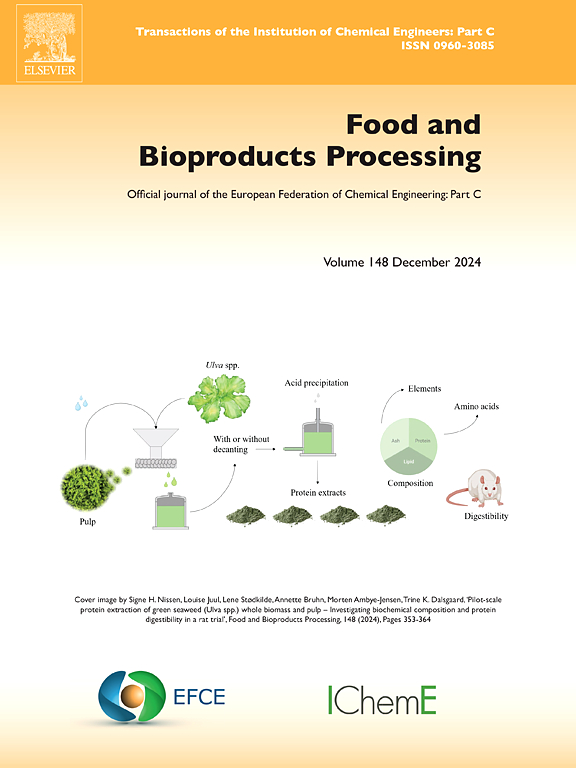Revealing the efficacy of postbiotics on the functional and nutritional characteristics of bioprocessed Nendran banana (Musa paradisiaca) flour for optimization of weaning mix
IF 3.5
2区 农林科学
Q2 BIOTECHNOLOGY & APPLIED MICROBIOLOGY
引用次数: 0
Abstract
The hidden hunger and micronutrient deficiency currently prevailing across the globe affecting nearly 45 million children, presents a worrying scenario, notwithstanding the ambitious target of the SDGs to eradicate all forms of malnutrition by 2023. Bioprocessing is being utilized as a promising tool for optimization of functional foods, controlled fermentation could be applied to foods to improve their nutritional and therapeutic potential. Nendran banana (Musa paradisiaca) flour is a complementary food introduced to children during the weaning phase. However, fortification is recommended for this weaning mix to compensate for the lack of certain essential nutrients. In this regard, the present study deals with the optimal bioprocessing conditions for Nendran banana flour via controlled fermentation with probiotic strain Lactobacillus rhamnosus GG 347 for varying time duration from 0 to 72 h to develop a weaning mix with postbiotic benefits. A notable improvement in the protein and starch digestibility were noticed in Nendran flour upon fermentation. Minerals including sodium, potassium, and magnesium found to be increased over the fermentation period. The in vitro protein digestibility was enhanced during fermentation from 31.06 ± 2.62–70.23 ± 3.47 %, while the percentage of starch hydrolysis also improved from 21 % to 73 %, rendering the complex starches in the raw Nendran flour into more easily digestible fractions. The polysaccharide content and the FTIR (Fourier Transmission Infrared Spectroscopy) analysis further validates the pattern of starch degradation over time. A distinct picture of structure degradation and deformities was observed on the surface of the particles via scanning electron microscopy. The efficacy of postbiotics in enhancing the antioxidant potential of the flour after L. rhamnosus fermentation was determined using a DPPH scavenging assay. 94.22 % radical scavenging activity was observed with 3 mg/mL crude extract concentration at a 36 h fermented sample. Thus, a weaning mix was optimized using Nendran banana flour fermented for 36 h with L. rhamnosus via D-optimal mixture design.
揭示后生物制剂对生物加工香蕉面粉功能和营养特性的影响,优化断奶配方
尽管可持续发展目标的宏伟目标是到2023年消除一切形式的营养不良,但目前全球普遍存在的隐性饥饿和微量营养素缺乏症仍令人担忧,影响着近4500万儿童。生物加工是一种很有前途的优化功能食品的工具,控制发酵可以应用于食品,以提高其营养和治疗潜力。Nendran banana (Musa paradisiaca)面粉是一种在断奶阶段引入儿童的辅食。然而,建议对这种断奶组合进行强化,以弥补某些必需营养素的缺乏。在这方面,本研究通过益生菌菌株鼠李糖乳杆菌GG 347控制发酵时间从0到72 h,以开发具有后生物效益的断奶混合物,研究了Nendran香蕉粉的最佳生物加工条件。发酵后,Nendran面粉的蛋白质和淀粉消化率显著提高。在发酵过程中,钠、钾和镁等矿物质的含量都有所增加。发酵过程中蛋白质体外消化率由31.06 ± 2.62 ~ 70.23 ± 3.47 %提高,淀粉水解率由21 %提高到73 %,使原料Nendran面粉中的复合淀粉更易消化。多糖含量和FTIR(傅里叶透射红外光谱)分析进一步验证了淀粉随时间降解的模式。通过扫描电子显微镜观察到颗粒表面明显的结构退化和变形。采用DPPH清除法测定了益生后制剂对鼠李糖发酵后面粉抗氧化能力的增强作用。粗提物浓度为3 mg/mL,发酵36 h,自由基清除率为94.22 %。因此,采用d -最优混合设计,以鼠李糖发酵36 h的Nendran香蕉粉为原料,优化断奶配方。
本文章由计算机程序翻译,如有差异,请以英文原文为准。
求助全文
约1分钟内获得全文
求助全文
来源期刊

Food and Bioproducts Processing
工程技术-工程:化工
CiteScore
9.70
自引率
4.30%
发文量
115
审稿时长
24 days
期刊介绍:
Official Journal of the European Federation of Chemical Engineering:
Part C
FBP aims to be the principal international journal for publication of high quality, original papers in the branches of engineering and science dedicated to the safe processing of biological products. It is the only journal to exploit the synergy between biotechnology, bioprocessing and food engineering.
Papers showing how research results can be used in engineering design, and accounts of experimental or theoretical research work bringing new perspectives to established principles, highlighting unsolved problems or indicating directions for future research, are particularly welcome. Contributions that deal with new developments in equipment or processes and that can be given quantitative expression are encouraged. The journal is especially interested in papers that extend the boundaries of food and bioproducts processing.
The journal has a strong emphasis on the interface between engineering and food or bioproducts. Papers that are not likely to be published are those:
• Primarily concerned with food formulation
• That use experimental design techniques to obtain response surfaces but gain little insight from them
• That are empirical and ignore established mechanistic models, e.g., empirical drying curves
• That are primarily concerned about sensory evaluation and colour
• Concern the extraction, encapsulation and/or antioxidant activity of a specific biological material without providing insight that could be applied to a similar but different material,
• Containing only chemical analyses of biological materials.
 求助内容:
求助内容: 应助结果提醒方式:
应助结果提醒方式:


